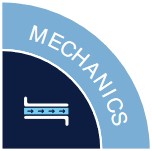FoodClean Explains
A Sinner’s Method to Improve Your Factory Hygiene

We don’t always follow the advice of a Sinner in order to get better hygiene results when looking at how best to clean and improve hygiene in our factories.
Of course, I’m talking about Dr. Hubert Sinner, former head of surfactant chemistry at Henkel in the late 1950’s. Dr. Sinner understood the effect and interrelation of all the factors involved in cleaning which he summarised into four groups: Mechanical, Time, Temperature and Chemistry. Together these form the so-called Sinner’s Circle.
Read on to learn how FoodClean use a clever manipulation of the Sinner’s Circle to supply cleaning products with unbeatable effectiveness.
The four components of the Sinner’s Circle

Mechanics: This refers to the agitation you can apply to the soil to dislodge it – by jet washing, brushing and/or scrubbing. This can be achieved in closed systems (i.e. cleaning in place (CIP)) via the use of spray balls which produce jets of cleaning chemical solution or in open plant cleaning (OPC) by, for example, brushing or scrubbing. The greater the mechanical agitation you can apply the more soil you can remove.

Time: The longer you allow the cleaning chemical to remain in contact with the soil, the more chemical action you will achieve, and the better the cleaning outcome. But time is precious and there is always an imperative to clean as quickly as possible. How can you simply and effectively increase the contact time of your cleaning chemical? Read on and we’ll explain all.
 Temperature: In some cases, temperature can accelerate the clean and remove soils such as fat and grease by softening them and making them easier to emulsify and remove. On the other hand, too high a temperature can hinder the removal of soil – protein is an example. Much like the common protein egg white (albumin) too high a temperature can solidify this type of soil making it difficult to remove. In addition, too high a temperature can damage the ingredients in a cleaning product and reduce their efficacy – an example here is hypochlorite (i.e. chlorine -‘hypo’) as applying chlorinated products too hot actually reduces their cleaning effect.
Temperature: In some cases, temperature can accelerate the clean and remove soils such as fat and grease by softening them and making them easier to emulsify and remove. On the other hand, too high a temperature can hinder the removal of soil – protein is an example. Much like the common protein egg white (albumin) too high a temperature can solidify this type of soil making it difficult to remove. In addition, too high a temperature can damage the ingredients in a cleaning product and reduce their efficacy – an example here is hypochlorite (i.e. chlorine -‘hypo’) as applying chlorinated products too hot actually reduces their cleaning effect.

Chemistry: The chemicals in the detergent are there to remove the soil and for each particular soil type or cleaning challenge there will be an appropriate cleaning product. The key is to use the right chemical at the optimum concentration dosage.
How the four components of the Sinner’s Circle interrelate
The principle behind the Sinner’s Circle is that if you, for example, reduce one component you will have to increase another, or all of the remaining, to maintain the cleaning effectiveness. For example, if you reduce the mechanical agitation you may need to increase the time of the clean. Alternatively, if you can find a way to increase one or more of the components then you may be able reduce the others. If this is done correctly you can save effort and reduce the cost of your clean.
What the Sinner’s Circle essentially teaches us is that if you want to decrease or increase one of the components you will need to make a corresponding increase or decrease of one, or all, of the others to compensate for the change.
But be warned – often people will try to simply increase the concentration of chemical product used in the hope that this will increase the cleaning effect or save them having to scrape and scrub – however, using the chemical product at higher than the recommended concentration could lead to damage or can even be a health and safety issue to your cleaning staff. We have often seen people use undiluted chemical products to remove difficult soils! This is a dangerous practice and is not how most cleaning products were designed to be used safely.
In the past many suppliers have produced cleaning products formulated to be applied as foams – this helps the product to ‘cling’ and thereby improve the contact time somewhat (and indirectly improves the chemistry as the ingredients have a longer lasting chemical effect). However, foams are not always enough – the contact time is not always sufficient as the foams can be quite wet and simply ‘slip’ off the surface after just a few minutes.
How FoodClean use the Sinner’s Circle to develop powerful cleaning products
 Here at FoodClean we have developed cleaning products which safely exploit the interrelated components of the Sinner’s Circle in order to boost and step up your cleaning to the highest level.
Here at FoodClean we have developed cleaning products which safely exploit the interrelated components of the Sinner’s Circle in order to boost and step up your cleaning to the highest level.
At FoodClean we have developed a range of proprietary cleaning products we call our Film range. These are available as caustics, chlorinated caustics and acids and can be used in CIP and open plant cleaning applications.
The concept of our film products is that the undiluted product, as supplied, is relatively ‘thin’ in terms of viscosity. It can therefore be pumped out of the container easily or drawn out of the drum using ‘pick ups’. It’s here that the clever chemistry starts! Our film products actually thicken when they’re diluted with water!
Dilution thickening: unlike most materials we normally encounter in life, our Film products have been designed to thicken when diluted. The result is that when applied via a foamer or other type of spray nozzle the product coming out of the nozzle, when applied to a surface to be cleaned, becomes thick and similar to a gel. This gel is able to cling to the surface for extended time scales to give an unbeatable contact time – 40 minutes or so is achievable. Unlike standard foams, which tend to drip off under their own weight in just a few minutes, our Film products can give incredible contact times.
It’s important to realise that our Film products are not like other gel products you can buy – these are gelled as supplied (as thick solutions which are difficult to spray) – our Film products are supplied to you as easily pumpable liquids which only thicken when needed: when you apply them to the surface to be cleaned.
So how do our Film products make use of the Sinner’s circle? By increasing the time that the product is active on the surface you also increase the chemical effect – this means you can reduce the mechanical effort you need to put in and also the temperature that you need to use – this can result in significant energy and cost savings to your business. As the increased contact time increases the chemical effect you also have the option to reduce the amount of chemical you use, thereby helping you to make savings in your chemical budget as well. Talk to our hygiene specialists today about how FoodClean’s innovative products can make a difference to your factory hygiene and how our Clean Factory Revolution connects Chemistry, Equipment (hygiene engineering systems), Protect (safety workwear) and Academy (training in our purpose built hands on FoodClean Experience Centre) all under one roof.
Talk to our hygiene specialists today about how FoodClean’s innovative products can make a difference to your factory hygiene and how our Clean Factory Revolution connects Chemistry, Equipment (hygiene engineering systems), Protect (safety workwear) and Academy (training in our purpose built hands on FoodClean Experience Centre) all under one roof.
Get in touch with our team at sales@foodclean.com or call +44 (0) 1522 703 703.
